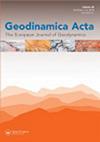Control of active faults and sea level changes on the distribution of shallow gas accumulations and gas-related seismic structures along the central branch of the North Anatolian Fault, southern Marmara shelf, Turkey
IF 1.5
Q1 Earth and Planetary Sciences
引用次数: 11
Abstract
Detailed reviews of multichannel seismic reflection, sparker, chirp and multibeam data that were collected on the southern Marmara Sea shelf revealed various shallow gas indicators and related sedimentary structures, including enhanced reflections, seismic chimneys, acoustic blanking, bright spots, pockmarks, mound-like features and seeps. Seismic attribute analyses were applied to characterise the existence of gas-bearing sediments. The distribution of shallow gas indicators provides important insights into their origin and the geological factors that control them. Prominent gas accumulations and seeps are observed along the profiles that cross the branches of the central segment of the North Anatolian Fault Zone, which indicates that the gas seeps are controlled by active faulting. This indicates that the faults act as conduits through the sedimentary column. The dense occurrences of gas directly off the river mouths along the shallow bays provide clues about the organic-rich carbon content of the sediments and biogenic methane generation. In some areas, the gas-related acoustic anomalies are mostly located in the upper sediments below the marine unit, which indicates that the gas emissions in these areas were terminated as a result of the increased overburden pressure after the Holocene sea level rise and the deposition of the marine unit.活动断裂和海平面变化对土耳其马尔马拉陆架南部北安那托利亚断裂带中央分支浅层天然气成藏及天然气相关地震构造分布的控制
通过对马尔马拉海南部陆架多通道地震反射、火花、啁啾和多波束数据的详细分析,揭示了浅层气体指示和相关沉积构造,包括反射增强、地震烟囱、声消隐、亮点、麻子、丘状特征和渗漏。应用地震属性分析方法对含气沉积物的存在进行表征。浅层含气指示物的分布为认识其成因及控制其形成的地质因素提供了重要依据。在北安那托利亚断裂带中部分支剖面上观察到明显的天然气聚集和渗流,表明天然气渗流受活动断裂控制。这表明断层在沉积柱中起着导管的作用。河口附近沿浅水湾密集分布的天然气为沉积物的富有机碳含量和生物甲烷生成提供了线索。部分地区气体相关声波异常多位于海洋单元以下的上层沉积物中,说明全新世海平面上升和海洋单元沉积后覆盖层压力增大导致该地区气体排放终止。
本文章由计算机程序翻译,如有差异,请以英文原文为准。
求助全文
约1分钟内获得全文
求助全文
来源期刊

Geodinamica Acta
地学-地球科学综合
CiteScore
4.50
自引率
0.00%
发文量
0
审稿时长
25 weeks
期刊介绍:
Geodinamica Acta provides an international and interdisciplinary forum for the publication of results of recent research dealing with both internal and external geodynamics. Its aims to promote discussion between the various disciplines that work on the dynamics of the lithosphere and hydrosphere. There are no constraints over themes, provided the main thrust of the paper relates to Earth''s internal and external geodynamics. The Journal encourages the submission of papers in all fields of earth sciences, such as biostratigraphy, geochemistry, geochronology and thermochronology, geohazards and their societal impacts, geomorphology, geophysics, glaciology, igneous and metamorphic petrology, magmatism, marine geology, metamorphism, mineral-deposits and energy resources, mineralogy, orogeny, palaeoclimatology, palaeoecology, paleoceanograpgy, palaeontology, petroleum geology, sedimentology, seismology and earthquakes, stratigraphy, structural geology, surface processes, tectonics (neoteoctonic, plate tectonics, seismo-tectonics, Active tectonics) and volcanism.
Geodinamica Acta publishes high quality, peer-reviewed original and timely scientific papers, comprehensive review articles on hot topics of current interest, rapid communications relating to a significant advance in the earth sciences with broad interest, and discussions of papers that have already appeared in recent issues of the journal. Book reviews are also included. Submitted papers must have international appeal and regional implications; they should present work that would be of interest to many different specialists. Geographic coverage is global and work on any part of the world is considered. The Journal also publishes thematic sets of papers on topical aspects of earth sciences or special issues of selected papers from conferences.
 求助内容:
求助内容: 应助结果提醒方式:
应助结果提醒方式:


